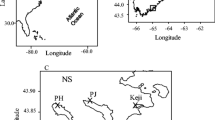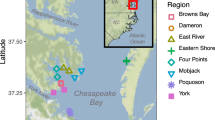Abstract
Seagrass species function as typical foundation species that unifies most ecosystem processes. This ecosystem role depends largely on the morphological characteristics and structural complexity of seagrass beds, including their ecological importance for fish species. This study examined relationships between seagrass bed characteristics and associated fish communities in mixed seagrass beds. Correspondence analysis (CA) and canonical correlation analysis (CCoA) were performed to estimate relationships for individual seagrass bed characteristics. The CCoA results revealed that species richness and three-dimensional structure of seagrass had great effect on the biomass and richness of the associated fish community. The CA results revealed that the relative importance of seagrass bed characteristics differed among fish functional groups including fishes appearing on the surface of, inside, and on the bottom of seagrass beds. The fishes found on the surface of the beds preferred beds with low seagrass biomass and high three-dimensional structure, those inside the beds preferred beds with high seagrass biomass and high three-dimensional structure, and those on the bottom of the beds preferred locations with low seagrass biomass and low three-dimensional structure. The results of this study provide compelling evidence that seagrass beds with high species diversity and high three-dimensional structure, but intermediate biomass, may provide the great benefit to the associated fish community. Such niche complementarity among fishes may be a process facilitated by seagrass diversity for secondary production as an ecosystem functioning.





Similar content being viewed by others
References
Agawin NSR, Duarte CM, Fortes MD (1996) Nutrient limitation of Philippine seagrasses (Cape Bolinao, NW Philippines): in situ experimental evidence. Mar Ecol Prog Ser 138:233–243. doi:https://doi.org/10.3354/meps138233
Altieri AH, Witman JD (2006) Local extinction of a foundation species in a hypoxic estuary: integrating individuals to ecosystem. Ecology 87:717–730. doi:https://doi.org/10.1890/05-0226
Baelde P (1990) Differences in the structures of fish assemblages in Thalassia testudinum beds in Guadeloupe, France West Indies, and their ecological significance. Mar Biol (Berl) 105:163–173. doi:https://doi.org/10.1007/BF01344282
Beck MW, Heck KLJ, Able KW, Childers DL, Eggleston DB, Gillanders BM, Halpern B, Hays CG, Hoshino K, Minello TJ, Orth RJ, Sheridan PF, Weinstein MP (2001) The identification, conservation and management of estuarine and marine nurseries for fish and invertebrates. Bioscience 51:633–641. doi:https://doi.org/10.1641/0006-3568(2001)051[0633:TICAMO]2.0.CO;2
Bell JD, Wstoby M (1986a) Importance of local changes in leaf height and density to fish and decapods associated with seagrasses. J Exp Mar Biol Ecol 104:249–274. doi:https://doi.org/10.1016/0022-0981(86)90109-7
Bell JD, Wstoby M (1986b) Variation in seagrass height and density over a wide spatial scale: effects on common fish and decapods. J Exp Mar Biol Ecol 104:275–295. doi:https://doi.org/10.1016/0022-0981(86)90109-7
Bruno JF, Bertness MD (2001) Habitat modification and facilitation in benthic marine communities. In: Bertness MD, Gaines SD, Hay ME (eds) Marine community ecology. Sinauer Associates, Sunderland, MA, pp 201–220
Chansang H, Poovachiranon S (1994) The distribution and species composition of seagrass beds along the Andaman Sea coast of Thailand. Phuket Mar Biol Cent Res Bull 59:43–52
Dayton PK (1972) Toward an understanding of community resilience and the potential effects of enrichment to the benthos of Mc Murdo Sound, Antarctica. In: Parker BC (ed) Proceedings of the colloquium on conservation problems in Antarctica. Allen Press, Lawrence, Kansas, pp 81–95
Edgar GJ, Robertson AI (1992) The influence of seagrass structure on the distribution and abundance of mobile epifauna: pattern and process in a Western Australian Amphibolis bed. J Exp Mar Biol Ecol 160:13–31. doi:https://doi.org/10.1016/0022-0981(92)90107-L
Edgar GJ, Shaw C, Watson GF, Hammond LS (1994) Comparisons of species richness, size-structure and production of benthos in vegetated and unvegetated habitats in Western-Port, Victoria. J Exp Mar Biol Ecol 176:201–226. doi:https://doi.org/10.1016/0022-0981(94)90185-6
Fortes MD (1988) Indo-west Pacific affinities of Philippine seagrasses. Bot Mar 31:237–242
Fredette TJ, Diaz RJ, van Montfrans J, Orth RJ (1990) Secondary production within a seagrass bed (Zostera marina and Ruppia maritime) in lower Chesapeake Bay. Estuaries 13:431–440. doi:https://doi.org/10.2307/1351787
Gratwiche B, Speight MR (2005a) Effects of habitat complexity on Caribbean, arine fish assemblages. Mar Ecol Prog Ser 292:301–310. doi:https://doi.org/10.3354/meps292301
Gratwiche B, Speight MR (2005b) The relationship between fish species richness, and abundance and habitat complexity in a range of shallow tropical marine habitats. J Fish Biol 66:650–667. doi:https://doi.org/10.1111/j.0022-1112.2005.00629.x
Guidetti P (2000) Differences among fish assemblages associated with nearshore Posidonia oceanica seagrass beds, rocky-algal reefs and unvegetated sand habitats in the Adriatic Sea. Estuar Coast Mar Sci 50:515–529
Guidetti P, Bussotti S (2002) Effects of seagrass canopy removal on fish in shallow Mediterranean seagrass (Cymodocea nodosa and Zostera noltii) meadows: a local-scale approach. Mar Biol (Berl) 140:445–453. doi:https://doi.org/10.1007/s00227-001-0725-1
Heck KLJ, Crowder LB (1991) Habitat structure and predator–prey interactions. In: Bell SS, McCoy E, Mushinsky H (eds) Habitat complexity: the physical arrangement of objects in space. Chapman & Hall, New York, pp 281–299
Heck KLJ, Wetstone GS (1977) Habitat complexity and invertebrates species richness and abundance in tropical seagrass meadows. J Biogeogr 4:135–142. doi:https://doi.org/10.2307/3038158
Heck KLJ, Able KW, Fahay MP, Roman CT (1989) Fishes and decapod crustaceans of Cape Cod eelgrass meadows: species composition, seasonal abundance patterns and comparison with unvegetated substrates. Estuaries 12:59–65. doi:https://doi.org/10.2307/1351497
Heck KLJ, Able KW, Fahay MP, Roman CT (1995) Composition, abundance, biomass and production of macrofauna in a New England estuary: comparison among eelgrass meadows and other nursery habitats. Estuaries 18:379–389. doi:https://doi.org/10.2307/1352320
Hemminga MA, Duarte CM (2000) Seagrass ecology. Cambridge University Press, Cambridge
Hori M (2006) Intertidal surfgrass as an allochthonous resource trap from the subtidal habitat. Mar Ecol Prog Ser 314:89–96. doi:https://doi.org/10.3354/meps314089
Horinouchi M, Sano M (1999) Effects of changes in seagrass shoot density and leaf height on abundances and distribution patterns on juveniles of three gobiid fishes in a Zostera marina bed. Mar Ecol Prog Ser 314:89–96
Hovel KA, Fonseca MS (2005) Influence of seagrass landscape structure on the juvenile blue crab habitat-survival function. Mar Ecol Prog Ser 300:179–191
Hyndes GA, Potter IC, Lenanton RCJ (1996) Habitat partitioning by whiting species (Sillaginidae) in coastal waters. Environ Biol Fishes 45:21–40. doi:https://doi.org/10.1007/BF00000625
Jenkins GP, Wheatley MJ (1998) The influence of habitat structure on nearshore fish assemblages in a southern Australian embayment: comparison of shallow seagrass, reef-algal and unvegetated sand habitats, with emphasis on their importance to recruitment. J Exp Mar Biol Ecol 221:147–172. doi:https://doi.org/10.1016/S0022-0981(97)00121-4
Jenkins GP, Keough MJ, Hamer PA (1998) The contributions of habitat structure and larval supply to broad-scale recruitment variability in a temperate zone, seagrass-associated fish. J Exp Mar Biol Ecol 226:259–278. doi:https://doi.org/10.1016/S0022-0981(97)00255-4
Jones MV, West RJ (2005) Spatial and temporal variability of seagrass fishes in intermittently closed and open coastal lakes in southeastern Australia. Estuar Coast Shelf Sci 64:277–288. doi:https://doi.org/10.1016/j.ecss.2005.02.021
Mellors JE (1991) An evaluation of a rapid visual technique for estimating seagrass biomass. Aquat Bot 42:67–73. doi:https://doi.org/10.1016/0304-3770(91)90106-F
Miyashita T, Takada M, Shimazaki Y (2004) Indirect effects of deer herbivory by deer reduce abundance and species richness of web spiders. Ecoscience 11:74–79
Moranta J, Palmer M, Morey G, Ruiz A, Morales-Nin B (2006) Multi-scale spatial variability in fish assemblages associated with Posidonia oceanica meadows in the Western Mediterranean Sea. Estuar Coast Shelf Sci 68:579–592. doi:https://doi.org/10.1016/j.ecss.2006.03.008
Nakaoka M, Supanwanid C (2000) Quantitative estimation of the distribution and biomass of seagrasses at Haad Chao Mai National Park, Trang province, Thailand. Kasetsart Univ Fish Res Bull 22:10–22
Nakaoka M, Tanaka Y, Watanabe M (2004) Species diversity and abundance of seagrasses in southwestern Thailand under different influence of river discharge. Coast Mar Sci 29:75–80
Orth RJ (1992) A perspective on plant-animal interactions in seagrasses: physical and biological determinants influencing plant and animal abundance. In: John DM, Hawkins SJ, Price JH (eds) Plant-animal interactions in the marine benthos. Clarendon Press, Oxford, pp 147–164
Orth RJ, Heck KLJ, van Montfrans J (1984) Seagrass faunal communities: a review of the influence of plant structure and prey characteristics on predator-prey relationship. Estuaries 7:339–350. doi:https://doi.org/10.2307/1351618
Pinto L, Punchihewa NN (1996) Utilization of mangroves and seagrasses by fishes in the Negombo estuary, Sri Lanka. Mar Biol (Berl) 126:333–345. doi:https://doi.org/10.1007/BF00347457
Pittman SJ, McAlpine CA, Pittman KM (2004) Linking fish and prawns to their environment: a hierarchical landscape approach. Mar Ecol Prog Ser 283:233–254. doi:https://doi.org/10.3354/meps283233
Pollard DA (1984) A review of ecological studies on seagrass-fish communities, with particular reference to recent studies in Australia. Aquat Bot 18:3–42. doi:https://doi.org/10.1016/0304-3770(84)90079-2
Rotherham D, West RJ (2002) Do different seagrass species support distinct fish communities in south-eastern Australia? Fish Manag Ecol 9:235–248. doi:https://doi.org/10.1046/j.1365-2400.2002.00301.x
Satapoomin U, Poovachiranon S (1997) Fish fauna of mangroves and seagrass beds in the west coast of Thailand, the Andaman Sea. Phuket Marine Biological Center, Phuket, Thailand
Stoner AW, Lewis FG (1985) The influence of quantitative and qualitative aspects of habitat complexity in tropical seagrass meadows. J Exp Mar Biol Ecol 94:19–40. doi:https://doi.org/10.1016/0022-0981(85)90048-6
Tanaka Y, Nakaoka M (2006) Morphological variation in the tropical seagrasses, Cymodocea serrulata and C. rotundata, in response to sediment conditions and light attenuation. Bot Mar 49:365–371. doi:https://doi.org/10.1515/BOT.2006.047
Telleria JL, Carrascal LM (1994) Weight-density relationships between and within bird communities: implications of niche space and vegetation structure. Am Nat 143:1083–1092. doi:https://doi.org/10.1086/285649
Thompson RC, Wilson BJ, Tobin ML, Hill AS, Hawkins SJ (1996) Biologically generated habitat provision and diversity of rocky shore organisms at a hierarchy of spatial scales. J Exp Mar Biol Ecol 202:73–82. doi:https://doi.org/10.1016/0022-0981(96)00032-9
Tomasko DA, Dawes CJ, Fortes MD, Large DB, Alava MNR (1993) Observations on a multi-species seagrass meadow offshores of Negros Oriental, Republic of the Philippines. Bot Mar 36:303–311
Turner SJ, Kendall MA (1999) A comparison of vegetated and unvegetated soft-sediment macrobenthic communities in the River Yealm, south-western Britain. J Mar Biol Assoc UK 79:741–743. doi:https://doi.org/10.1017/S0025315499000892
Tuya F, Boyra A, Sanchez-Jerez P, Haroun RJ (2005) Multivariate analysis of the bentho-demersal ichthyofauna along soft bottoms of the Eastern Atlantic: comparison between unvegetated substrates, seagrass meadows and sandy bottoms beneath sea-cage fish farms. Mar Biol (Berl) 147:1229–1237. doi:https://doi.org/10.1007/s00227-005-0018-1
Valentine JF, Heck KLJ (1993) Mussels in seagrass meadows: their influence on macroinvertebrate abundance and secondary production in the northern Gulf of Mexico. Mar Ecol Prog Ser 96:63–74. doi:https://doi.org/10.3354/meps096063
Vermaat JE, Agawin NSR, Duarte CM, Fortes MD, Marba N, Uri JS (1995) Meadow maintenance, growth and productivity of a mixed Philippine seagrass bed. Mar Ecol Prog Ser 124:215–225. doi:https://doi.org/10.3354/meps124215
Walker DI, Olesen B, Phillips RC (2001) Reproduction and phenology in seagrasses. In: Short FT, Coles RG (eds) Global seagrass research methods. Elsevier, Amsterdam, The Netherlands, pp 59–78
Walter RP, Haynes JM (2006) Fish and coral community structure are related on shallow water patch reefs near San Salvador, Bahamas. Bull Mar Sci 79:365–374
Williams SL, Heck KLJ (2001) Seagrass community ecology. In: Bertness MD, Gaines SD, Hay ME (eds) Marine community ecology. Sinaure Associates, Sunderland, MA, pp 317–338
Williams SE, Marsh H, Winter J (2002) Spatial scale, species diversity, and habitat structure: small mammals in Australian tropical rain forest. Ecology 83:1317–1329
Yamada K, Hori M, Tanaka Y, Hasegawa N, Nakaoka M (2007) Temporal and spatial macrofaunal community changes along a salinity gradient in seagrass meadows of Akkeshi-ko estuary and Akkeshi Bay, northern Japan. Hydorobiologia 592:345–358. doi:https://doi.org/10.1007/s10750-007-0767-6
Acknowledgments
We are grateful to S. Pleumarom and the staff of Ranong Coastal Resource Research Station, Kasetsart University for logistical support during fieldwork, and C. Aryuthaka for her management of our research trip in Thailand. We are also grateful to K. Yamada and members of National Research Institute of Fisheries and Environment of Inland Sea, Fishery Research Agency Japan for their assistance in conducting this study. This article is partially funded by the grants-in-aid from the Ministry of Education, Culture, Sports, Science and Technology, Japan (No. 16405007).
Author information
Authors and Affiliations
Corresponding author
Additional information
Communicated by T. Reusch.
Rights and permissions
About this article
Cite this article
Hori, M., Suzuki, T., Monthum, Y. et al. High seagrass diversity and canopy-height increase associated fish diversity and abundance. Mar Biol 156, 1447–1458 (2009). https://doi.org/10.1007/s00227-009-1184-3
Received:
Accepted:
Published:
Issue Date:
DOI: https://doi.org/10.1007/s00227-009-1184-3




